Performance of Thermally Modified Spruce Timber in Outdoor Above-Ground Conditions: Checking, Dynamic Stiffness and Static Bending Properties
Abstract
1. Introduction
2. Materials and Methods
2.1. Timber and Thermal Modification
2.2. Experimental
2.2.1. Weathering
2.2.2. Non-Destructive Tests (NDTs)
2.2.3. Conditioning
2.2.4. Bending Tests
2.2.5. Degree of Checking: Board Surface
2.2.6. Degree of Checking: Board Cross-Section
2.3. Data Analysis
2.3.1. Calculation of Board Properties
2.3.2. Digital Image Processing
2.3.3. Statistics
3. Results and Discussion
3.1. Degree of Checking
3.1.1. Board Cross-Section
3.1.2. Board Surface: Digital Image Processing
3.1.3. Board Surface: Visual Assessment
3.2. Board Properties
3.2.1. Non-Destructive Tests
3.2.2. Board Properties
4. Conclusions
Author Contributions
Funding
Acknowledgments
Conflicts of Interest
Availability of data
Abbreviations
| 4PB | 4-point bending |
| Ea,res | Axial dynamic stiffness based on va,res and ρ |
| Ea,tof | Axial dynamic stiffness based on va,tof and ρ |
| Em,g | Modulus of elasticity (MOE) based on global deflections in static bending |
| Em,l | MOE based on local deflections in static bending |
| fa,1 | Frequency of the first mode of axial vibration |
| fm | Static edgewise bending strength |
| MC | Moisture content |
| NDT | Non-destructive test |
| t | Time to failure |
| TM | Thermally modified |
| TMT | Thermally modified timber |
| TMW | Thermally modified wood |
| Tof | Time-of-flight |
| va,tof | Acoustic velocity based on Δt and board’s length L |
| va,res | Acoustic velocity based on fa,1 and board’s length L |
| wmax | Global deflection at maximum load |
| WML | Work-to-maximum load in static bending |
| Δt | Time-of-flight of stress wave |
| ρ | Air-dry density of board |
References
- Rowell, R.M.; Andersone, I.; Andersons, B. Heat Treatment. In Handbook of Wood Chemistry and Wood Composites; Rowell, R.M., Ed.; CRC Press LLC: Boca Raton, FL, USA, 2013; pp. 511–536. [Google Scholar]
- Militz, H. Thermal Treatment of Wood: European Processes and Their Background; International Reserach Group on Wood Protection: Stockholm, Sweden, 2002. [Google Scholar]
- Altgen, M.; Militz, H. Influence of process conditions on hygroscopicity and mechanical properties of European beech thermally modified in a high-pressure reactor system. Holzforsch 2016, 70, 971–979. [Google Scholar] [CrossRef]
- Larsson-Brelid, P. Benchmarking and State of the Art for Modified Wood; SP Research Institude of Sweden: Borås, Sweden, 2013. [Google Scholar]
- International ThermoWood Association. ThermoWood® Production Statistics 2019. Available online: https://asiakas.kotisivukone.com/files/thermowood.palvelee.fi/uutiset/Productionstatistics2019.pdf (accessed on 5 February 2020).
- Stod, R.-M. Retail Price ThermoWood® Thermo-D Spruce Wood, 14 October 2019.
- Welzbacher, C.R.; Rapp, A.O. Durability of thermally modified timber from industrial-scale processes in different use classes: Results from laboratory and field tests. Wood Mater. Sci. Eng. 2007, 2, 4–14. [Google Scholar] [CrossRef]
- Metsä-Kortelainen, S.; Paajanen, L.; Viitanen, H. Durability of thermally modified Norway spruce and Scots pine in above-ground conditions. Wood Mater. Sci. Eng. 2011, 6, 163–169. [Google Scholar] [CrossRef]
- Metsä-Kortelainen, S.; Viitanen, H. Durability of thermally modified sapwood and heartwood of Scots pine and Norway spruce in the modified double layer test. Wood Mater. Sci. Eng. 2017, 12, 129–139. [Google Scholar] [CrossRef]
- EN 335-2. Durability of Wood and Wood-Based Products—Definition of Use Classes—Part 2: Application to Solid Wood; European Committee for Standardization (CEN): Brussels, Belgium, 2006. [Google Scholar]
- Hill, C.A.S. Wood Modification: Chemical, Thermal and Other Processes; John Wiley & Sons, Ltd.: West Sussex, UK, 2006. [Google Scholar]
- International ThermoWood Association. ThermoWood Handbook; International ThermoWood Association: Helsinki, Finland, 2003. [Google Scholar]
- Rowell, R.M.; Ibach, R.E.; McSweeny, J.; Nilsson, T. Understanding decay resistance, dimensional stability and strength changes in heat treated and acetylated wood. In Proceedings of the 4th European Conference on Wood Modification, Stockholm, Sweden, 1 January 2009; pp. 489–502. [Google Scholar]
- Kubovský, I.; Kačíková, D.; Kačík, F. Structural changes of oak wood main components caused by thermal modification. Polymers 2020, 12, 485. [Google Scholar] [CrossRef] [PubMed]
- Stamm, A.J.; Horace, K.; Burr, K.; Kline, A.A. Staybwood—Heat-stabilized wood. Ind. Eng. Chem. 1946, 38, 630–634. [Google Scholar] [CrossRef]
- Windeisen, E.; Bächle, H.; Zimmer, B.; Wegener, G. Relations between chemical changes and mechanical properties of thermally treated wood. Holzforsch 2009, 63, 773–778. [Google Scholar]
- Kubojima, Y.; Okano, T.; Ohta, M. Bending strength and toughness of heat-treated wood. J. Wood Sci. 2000, 46, 8–15. [Google Scholar] [CrossRef]
- Boonstra, M.J.; Van Acker, J.; Tjeerdsma, B.F.; Kegel, E.V. Strength properties of thermally modified softwoods and its relation to polymeric structural wood constituents. Ann. For. Sci. 2007, 64, 679–690. [Google Scholar] [CrossRef]
- Tukiainen, P.; Hughes, M. The effect of elevated temperature and high moisture content on the fracture behaviour of thermally modified spruce. J. Mater. Sci. 2016, 51, 1437–1444. [Google Scholar] [CrossRef]
- Gaff, M.; Kačík, F.; Sandberg, D.; Babiak, M.; Turčani, M.; Niemz, P.; Hanzlík, P. The effect of chemical changes during thermal modification of European oak and Norway spruce on elasticity properties. Compos. Struct. 2019, 220, 529–538. [Google Scholar] [CrossRef]
- van Blokland, J.; Olsson, A.; Oscarsson, J.; Adamopoulos, A. Prediction of bending strength of thermally modified timber using high-resolution scanning of fibre direction. Eur. J. Wood Prod. 2019, 77, 327–340. [Google Scholar] [CrossRef]
- van Blokland, J.; Adamopoulos, A.; Olsson, A.; Oscarsson, J.; Källander, B. Evaluation of non-destructive test methods to predict bending properties of thermally modified timber. In Proceedings of the World Conference on Timber Engineering, Seoul, Korea, 20–23 August 2018. [Google Scholar]
- van Blokland, J.; Olsson, A.; Oscarsson, J.; Daniel, G.; Adamopoulos, A. Crack formation, strain distribution and fracture surfaces around knots in thermally modified timber loaded in static bending. Wood Sci. Technol. 2020. [Google Scholar] [CrossRef]
- Riggio, M.; Anthony, R.W.; Augelli, F.; Kasal, B.; Lechner, T.; Muller, W.; Tannert, T. In situ assessment of structural timber using non-destructive techniques. Mater. Struct. 2014, 47, 749–766. [Google Scholar] [CrossRef]
- Legg, M.; Bradley, S. Measurement of stiffness of standing trees and felled logs using acoustics: A review. J. Acoust. Soc. Am. 2016, 139, 588–604. [Google Scholar] [CrossRef]
- Sandoz, J.L. Grading of construction timber by ultrasound. Wood Sci. Technol. 1989, 23, 95–108. [Google Scholar] [CrossRef]
- Hanhijärvi, A.; Ranta-Maunus, A. Development of strength grading of timber using combined measurement techniques. Report of the Combigrade-project—Phase 2. VTT Publ. 2008, 686. Available online: https://www.vttresearch.com/sites/default/files/pdf/publications/2008/P686.pdf (accessed on 5 February 2020).
- Olsson, A.; Oscarsson, J.; Johansson, M.; Källsner, B. Prediction of timber bending strength on basis of bending stiffness and material homogeneity assessed from dynamic excitation. Wood Sci. Technol. 2012, 46, 667–683. [Google Scholar] [CrossRef]
- Kang, H.; Booker, R.E. Variation of stress wave velocity with MC and temperature. Wood Sci. Technol. 2002, 36, 41–54. [Google Scholar] [CrossRef]
- Yang, H.; Yu, L.; Wang, L. Effect of moisture content on the ultrasonic properties of wood. J. For. Res. 2015, 26, 753–757. [Google Scholar] [CrossRef]
- Green, D.W.; Evans, J.W.; Logan, J.D.; Allen, J. Temperature corrections for mechanically graded lumber. In Proceedings of the World Conference on Timber Engineering, Montreux, Switzerland, 17–20 August 1998; pp. 844–845. [Google Scholar]
- Chan, M.J.; Walker, C.J.; Raymond, C.A. Effect of moisture content and temperature on acoustic velocity and dynamic MOE of radiata pine sapwood boards. Wood Sci. Technol. 2011, 45, 609–626. [Google Scholar] [CrossRef]
- Unterwieser, H.; Schickhofer, G. Influence of moisture content of wood on sound velocity and dynamic MOE of natural frequency- and ultrasonic runtime measurement. Eur. J. Wood Prod 2011, 69, 171–181. [Google Scholar] [CrossRef]
- Llana, D.F.; Iñiguez-Gonzalez, G.; Arriaga, F.; Niemz, P. Influence of temperature and moisture content on non-destructive measurements in Scots pine wood. Wood Res. 2014, 59, 769–780. [Google Scholar]
- Baar, J.; Tippner, J.; Gryc, V. The influence of wood density on longitudinal wave velocity determined by the ultrasound method in comparison to the resonance longitudinal method. Eur. J. Wood Prod 2012, 70, 767–769. [Google Scholar] [CrossRef]
- Brancheriau, L.; Bailleres, H. Natural vibration analysis of clear wooden beams: A theoretical review. Wood Sci. Technol. 2002, 36, 347–365. [Google Scholar] [CrossRef]
- de Borst, K.; Bader, T.K.; Wikete, C. Microstructure-stiffness relationships of Ten european and tropical hardwood species. J. Struct. Biol. 2012, 177, 532–542. [Google Scholar] [CrossRef] [PubMed]
- Evans, P.D. Weathering of wood and wood composites. In Handbook of Wood Chemistry and Wood Composites; Rowell, R.M., Ed.; CRC Press: Boca Raton, FL, USA, 2013; pp. 151–216. [Google Scholar]
- Feist, W.C. Weathering of wood in structural uses. In Structural Use of Wood in Adverse Environments; Meyer, R.W., Kellogg, R.M., Eds.; Van Nostrand Reinhold Co.: New York, NY, USA, 1982. [Google Scholar]
- Feist, W.C.; Hon, D.N.-S. Chemistry of weathering and protection. In The Chemistry of Solid Wood; Rowell, R.M., Ed.; American Chemial Society: Washingion, DC, USA, 1984; pp. 401–450. [Google Scholar]
- Jirouš-Rajković, V.; Miklečić, J. Weathering resistance of modified wood—A review. Proceedings of Jubilee Annual 2017–2018 of the Croatian Academy of Engineering, Zagreb, Croatia; 2018; pp. 223–246. [Google Scholar]
- Kollmann, F.F.P.; Côté, W.A. Principles of Wood Science and Technology. I Solid Wood; Springer: New York, NY, USA, 1968. [Google Scholar]
- Tsoumis, G.T. Science and Technology of Wood: Structure, Properties, Utilization; Van Nostrand Reinhold: New York, NY, USA, 1991. [Google Scholar]
- Kollmann, F.F.P. Mechanics and rheology of wood. In Principles of Wood Science and Technology: I Solid Wood; Kollmann, F.F.P., Côté, W.A.J., Eds.; Springer: New York, NY, USA, 1968. [Google Scholar]
- Urban, K.; Evans, P.D. Preliminary Observations of the Effect of Growth Ring Orientation on the Surface Checking of Flat Sawn Southern Pine Decking; International Research Group on Wood Protection (IRG/WP): Bangalore, India, 2005. [Google Scholar]
- Sandberg, D. Radially sawn timber: The influence of annual ring orientation on crack formation and deformation in water soaked pine (Pinus silvestris L.) and spruce (Picea abies Karst.). Eur. J. Wood Prod 1997, 55, 175–182. [Google Scholar] [CrossRef]
- Sandberg, D. The influence of pith and juvenile wood on proportion of cracks in sawn timber when kiln dried and exposed to wetting cycles. Holz als Roh- Und Werkstoff 1996, 54. [Google Scholar] [CrossRef]
- Sandberg, D. Weathering of radial and tangential wood surfaces of pine and spruce. Holzforsch 1999, 53, 355–364. [Google Scholar] [CrossRef]
- Altgen, M.; Adamopoulos, S.; Militz, H. Wood defects during industrial-scale production of thermally modified Norway spruce and Scots pine. Wood Mater. Sci. Eng. 2017, 12, 14–23. [Google Scholar] [CrossRef]
- Johansson, D. Influences of drying on internal checking of spruce (Picea abies L.) heat-treated at 212 °C. Holzforsch 2006, 60, 558–560. [Google Scholar] [CrossRef]
- Feist, W.C.; Sell, J. Weathering behavior of dimensionally stabilized wood treated by heating under pressure of nitrogen gas. Wood Fiber Sci. 1987, 19, 183–195. [Google Scholar]
- Jämsä, S.; Ahola, P.; Viitaniemi, P. Long-term natural weathering of coated ThermoWood. Pigment. Resin Technol. 2000, 29, 68–74. [Google Scholar] [CrossRef]
- Dubey, M.K.; Pang, S.; Walker, J. Color and dimensional stability of oil heat-treated radiata pinewood after accelerated UV weathering. For. Prod J. 2010, 60, 453–459. [Google Scholar] [CrossRef]
- Miklečić, J.; Jirouš-Rajković, V.; Pervan, S.; Grujić, S. Oils usage in finishing of thermally modified wood in outdoor applications. In Proceedings of the Wood is Good—Transfer of Knowledge in Practice as a Way out of the Crisis, Zagreb, Croatia, 15 October 2010; pp. 89–96. [Google Scholar]
- Ala-Viikari, J.; Mayes, D. New generation ThermoWood®―How to take ThermoWood® to the next level. In Proceedings of the 4th European Conference on Wood Modification (ECWM), Stockholm, Sweden, 27–29 April 2009; pp. 23–29. [Google Scholar]
- EN ISO 4628-4. Paint and Varnishes—Evaluation of Degradation of Coatings—Designation of Quantity and Size of Defects, and of Intensity of Uniform Changes in Apparearance—Part 4: Assessment of Degree of Cracking; European Committee for Standardization (CEN): Brussels, Belgium, 2016. [Google Scholar]
- Stirling, R. Natural Durability Classification Systems Used Around the World; International Research Group on Wood Protection: Beijing, China, 2009. [Google Scholar]
- Brischke, C.; Welzbacher, C.R.; Meyer, L.; Bornemann, T.; Larsson-Brelid, P.; Pilgård, A.; Frühwald Hansson, E.; Westin, M.; Rapp, A.O.; Thelandersson, S.; et al. Service Life Prediction of Wooden Components—Part 3: Approaching a Comprehensive Test Methodology; International Research Group on Wood Preservation: Queenstown, New Zealand, 2011. [Google Scholar]
- Vorobyev, A. Non-Contact Computer Aided in-Field Surface Measuring Techniques of Cracks in Glued Laminated Beams; Luleå University of Technology: Luleå, Sweden, 2012. [Google Scholar]
- Boonstra, M.J.; Van Acker, J.; Kegel, E.V. Effect of a two-stage heat treatment process on the mechanical properties of full construction timber. Wood Mater. Sci. Eng. 2007, 2, 138–146. [Google Scholar] [CrossRef]
- Lamb, F.M. Splits and Cracks in Wood; Western Dry Kiln Association: Corvallis, OR, USA, 1992. [Google Scholar]
- EN 14081-1. Timber Structures—Strength Graded Structural Timber with Rectangular Cross Section—Part 1: General; European Committee for Standardization (CEN): Brussels, Belgium, 2016. [Google Scholar]
- EN 1912. Structural Timber—Strength Classes—Assignment of Visual Grades and Species; European Committee for Standardization (CEN): Brussels, Belgium, 2012. [Google Scholar]
- EN 13183-1. Moisture Content of a Piece of Sawn Timber—Part 1: Determination by Oven Dry Method; European Committee for Standardization (CEN): Brussels, Belgium, 2002. [Google Scholar]
- EN 408. Structural Timber—Structural Timber and Glued Laminated Timber—Determination of Some Physical and Mechanical Properties; European Committee for Standardization (CEN): Brussels, Belgium, 2012. [Google Scholar]
- ASTM D143-94. Standard Test Methods for Small Clear Specimens of Timber; ASTM International: West Conshohocken, PA, USA, 2000. [Google Scholar]
- INSTA 142. Nordic Visual Strength Grading Rules for Timber (in Swedish); Swedish Standards Institute (SIS): Stockholm, Sweden, 2010. [Google Scholar]
- EN 384. Structural Timber—Determination of Characteristic Values of Mechanical Properties and Density; European Committee for Standardization (CEN): Brussels, Belgium, 2016. [Google Scholar]
- Paulínyová, J.M.; Čunderlík, I. Chosen physical properties of spruce juvenile wood (Picea abies Karst). In Proceedings of the 5th IUFRO Symposium “Wood Structure and Properties ’06”, Sliač-Sielnica, Slovakia, 3–6 September 2006; pp. 93–97. [Google Scholar]
- Bengtsson, C.; Betzold, D. Bending strength and stiffness of Norway spruce timber—influence of high temperature drying. In Proceedings of the International Symposium on Wood Machining, Vienna, Austria, 27–29 September 2000; pp. 139–149. [Google Scholar]
- Bengtsson, C.; Jermer, J.; Brem, F. Bending Strength of Heat-Treated Spruce and Pine Timber; International Research Group on Wood Preservation: Cardiff, Wales, 12–17 May 2002. [Google Scholar]
- Ranta-Maunus, A.; Denzler, J.K.; Stapel, P. Strength of European Timber—Part 2. Properties of Spruce and Pine Tested in Gradewood Project; VTT: Esbo, Finland, 2011. [Google Scholar]
- Widmann, R.; Fernandez-Cabo, J.L.; Steiger, R. Mechanical properties of thermally modified beech timber for structural purposes. Eur. J. Wood Prod. 2012, 70, 775–784. [Google Scholar] [CrossRef]
- Niemz, P.; Mannes, D. Non-destructive testing of wood and wood-based materials. J. Cult. Herit. 2012, 13, 26–34. [Google Scholar] [CrossRef]
- Montero, M.J.; de la Mata, J.; Esteban, M.; Hermoso, E. Influence of moisture content on the wave velocity to estimate mechanical properties of large cross-section pieces for structural use of scots pine from spain. Maderas. Cienc. Y Tecnol. 2015, 17, 407–420. [Google Scholar] [CrossRef]
- Sandoz, J.L. Moisture content and temperature effect on ultrasonic timber grading. Wood Sci. Technol. 1993, 27, 373–380. [Google Scholar]
- Arnold, M. Effect of moisture on the bending properties of thermally modified beech and spruce. J. Mater. Sci. 2010, 45, 669–680. [Google Scholar] [CrossRef]
- Oberhofnerová, E.; Arnetová, K.; Holeček, T.; Borůvka, V.; Bomba, J. Determination of correlation between destructive and nondestructive test methods applied on modified wood exposed to natural weathering. BioResources 2016, 11, 5155–5168. [Google Scholar] [CrossRef]
- Ceccotti, A.; Togni, M. NDT on ancient timber beams: Assessment of strength/stiffness properties combining visual and instrumental methods. In Proceedings of the 10th International Symposium on Nondestructive Testing of Wood, Lausanne, Switzerland, 26–28 August 1996; pp. 379–388. [Google Scholar]
- Kasal, B.; Lear, G.; Tannert, T. Stress waves. In In Situ Assessment of Structural Timber; Kasal, B., Tannert, T., Eds.; Springer: Dordrecht, The Netherlands, 2011; Volume 7. [Google Scholar]
- Johansson, C.-J.; Boström, L.; Bräuner, L.; Hoffmeyer, P.; Holmquist, C.; Solli, K.H. Laminations for Glued Laminated Timber—Establishment of Strength Classes for Visual Strength Grades and Machine Settings for Glulam Laminations of Nordic Origin; SP Swedish National Testing and Research Institute: Borås, Sweden, 1998; p. 38. [Google Scholar]
- Olsson, A.; Oscarsson, J. Strength grading on the basis of high resolution laser scanning and dynamic excitation: A full scale investigation of performance. Eur. J. Wood Prod 2017, 75, 17–31. [Google Scholar] [CrossRef]
- Wang, X. Acoustic measurements on trees and logs: A review and analysis. Wood Sci. Technol. 2013, 47, 965–975. [Google Scholar] [CrossRef]
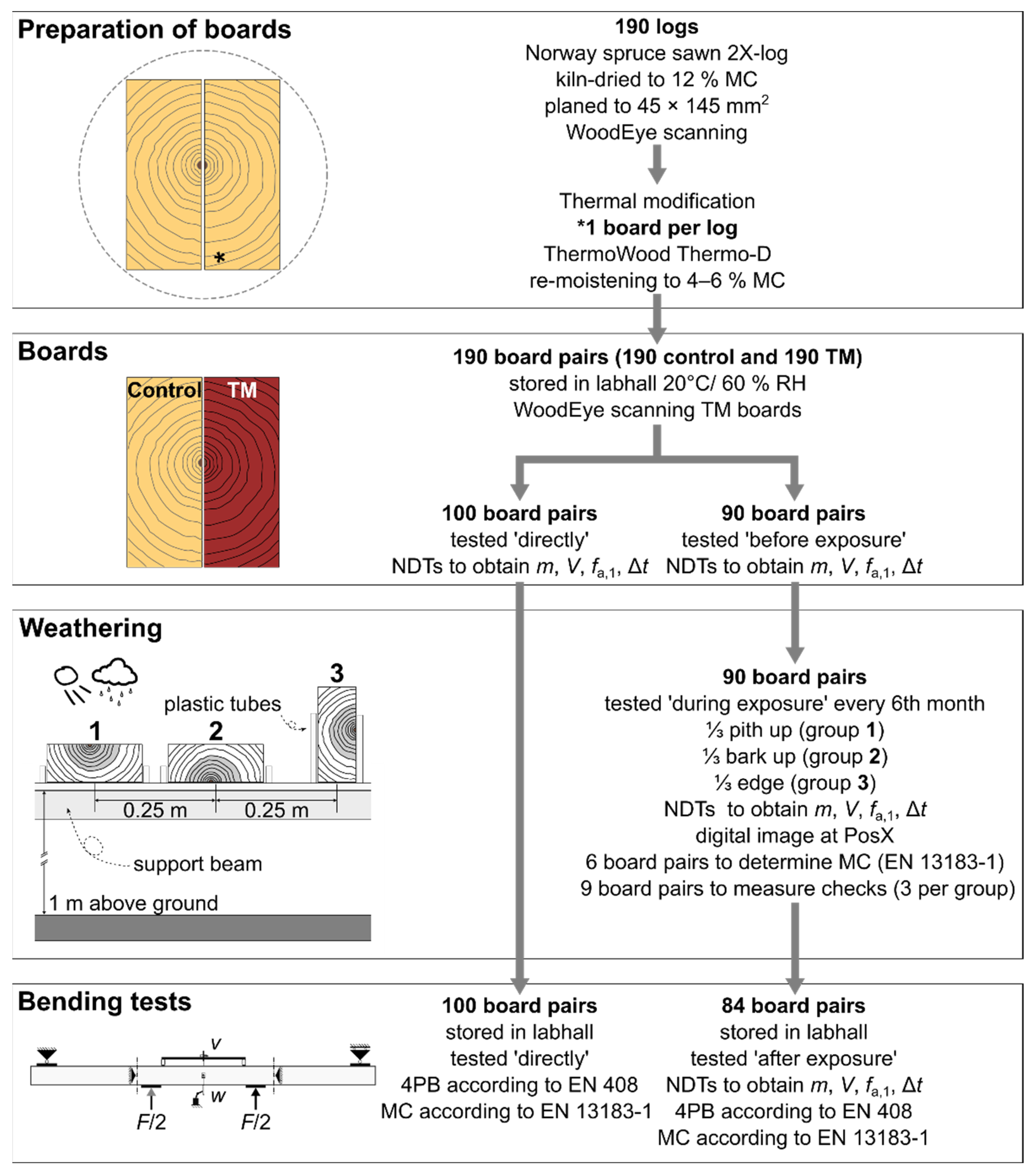

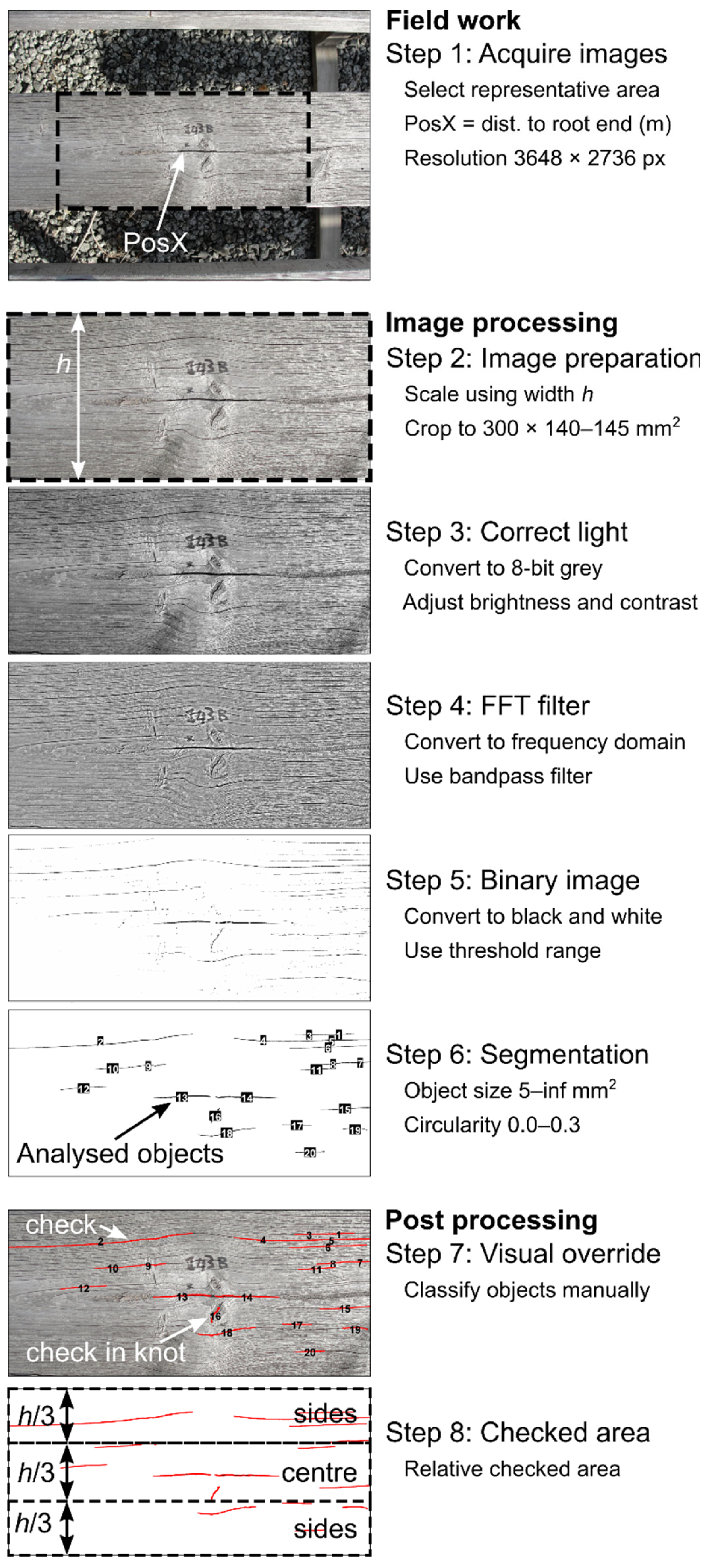


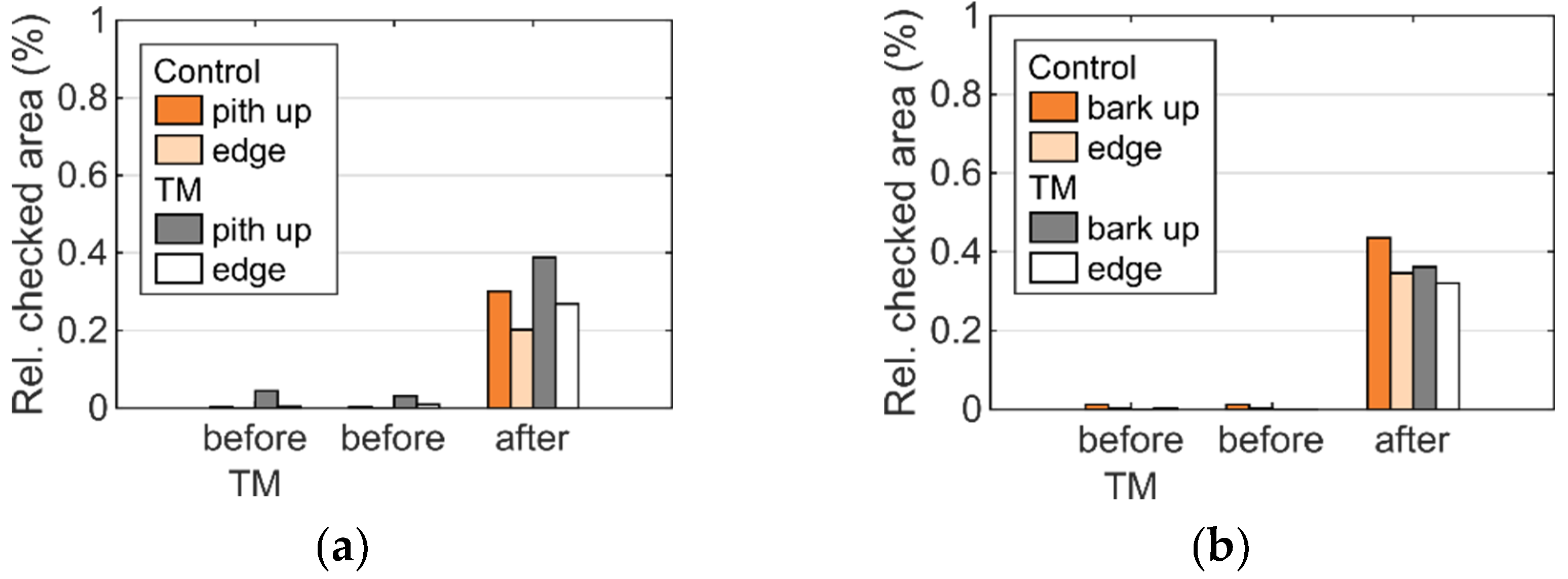
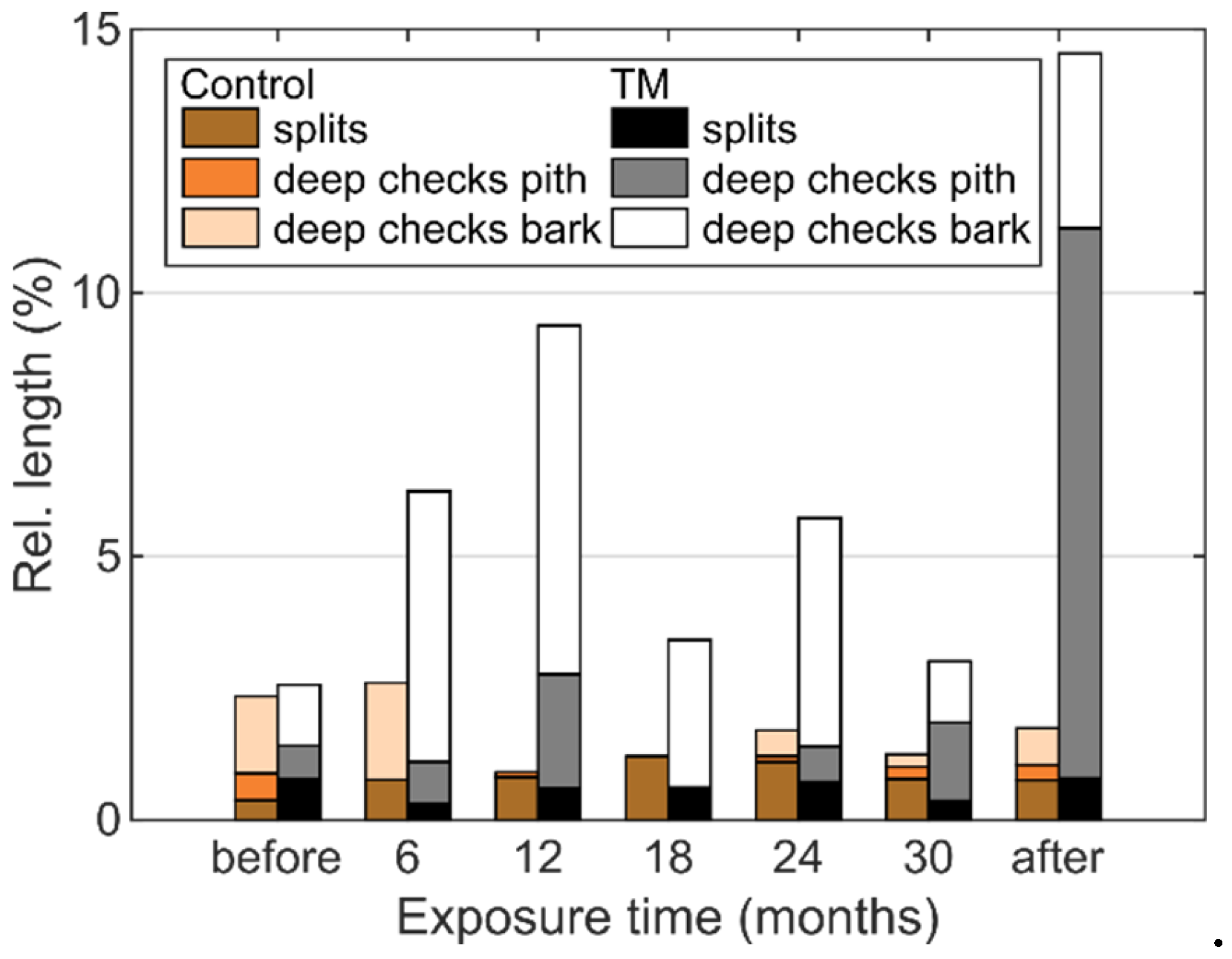
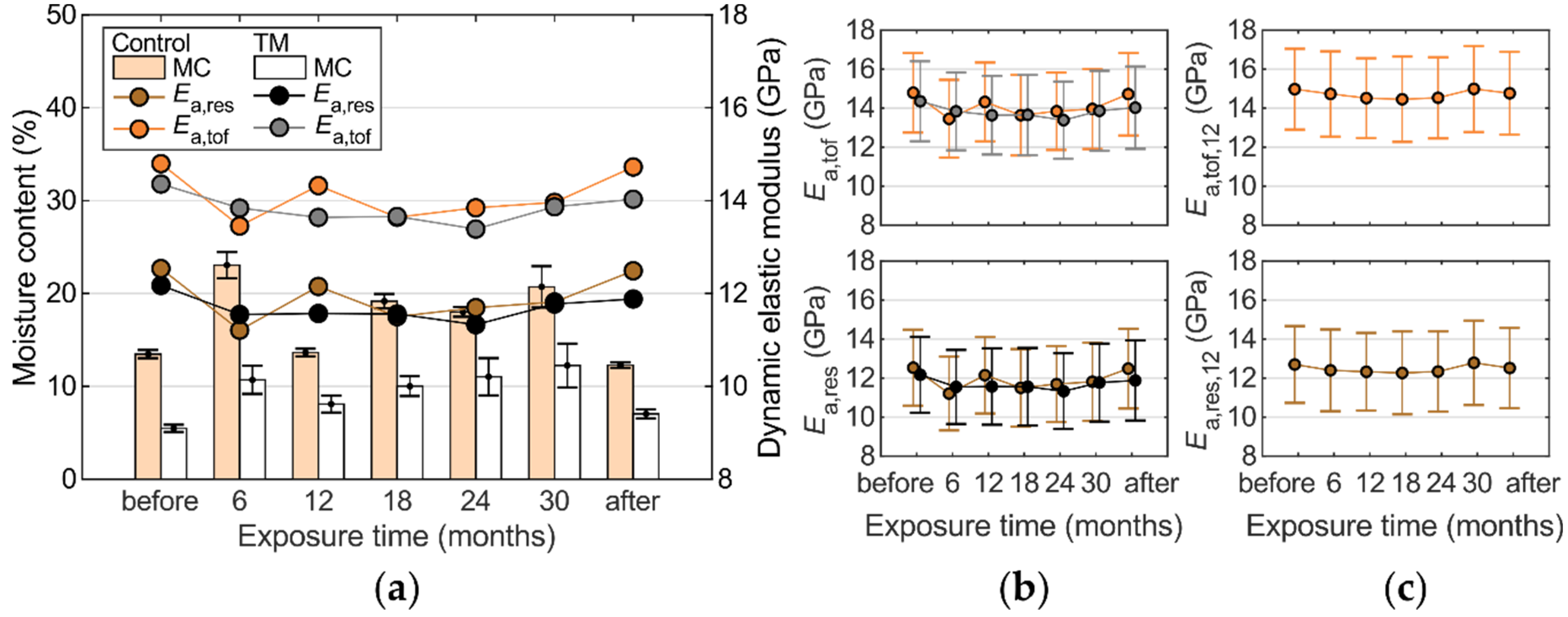
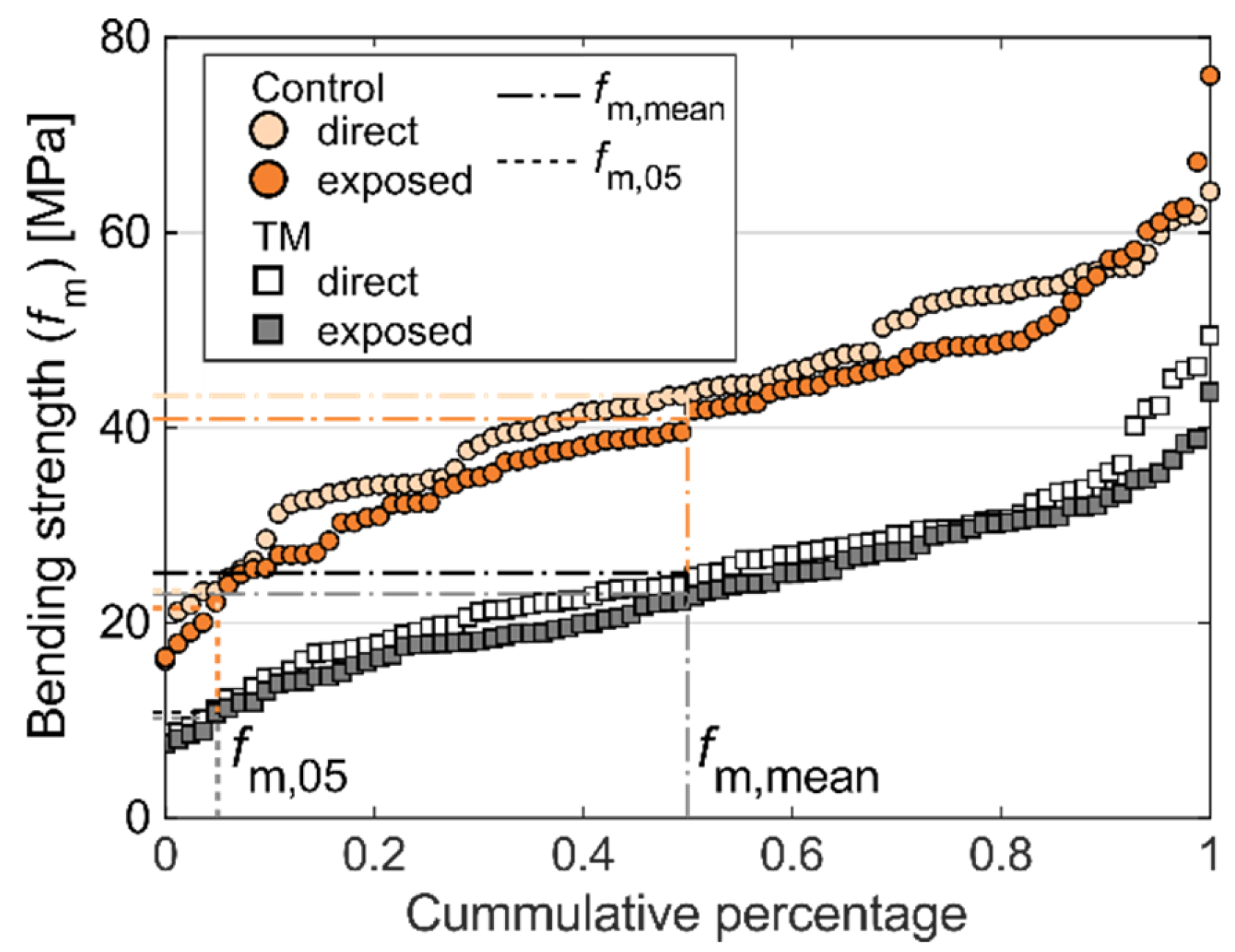
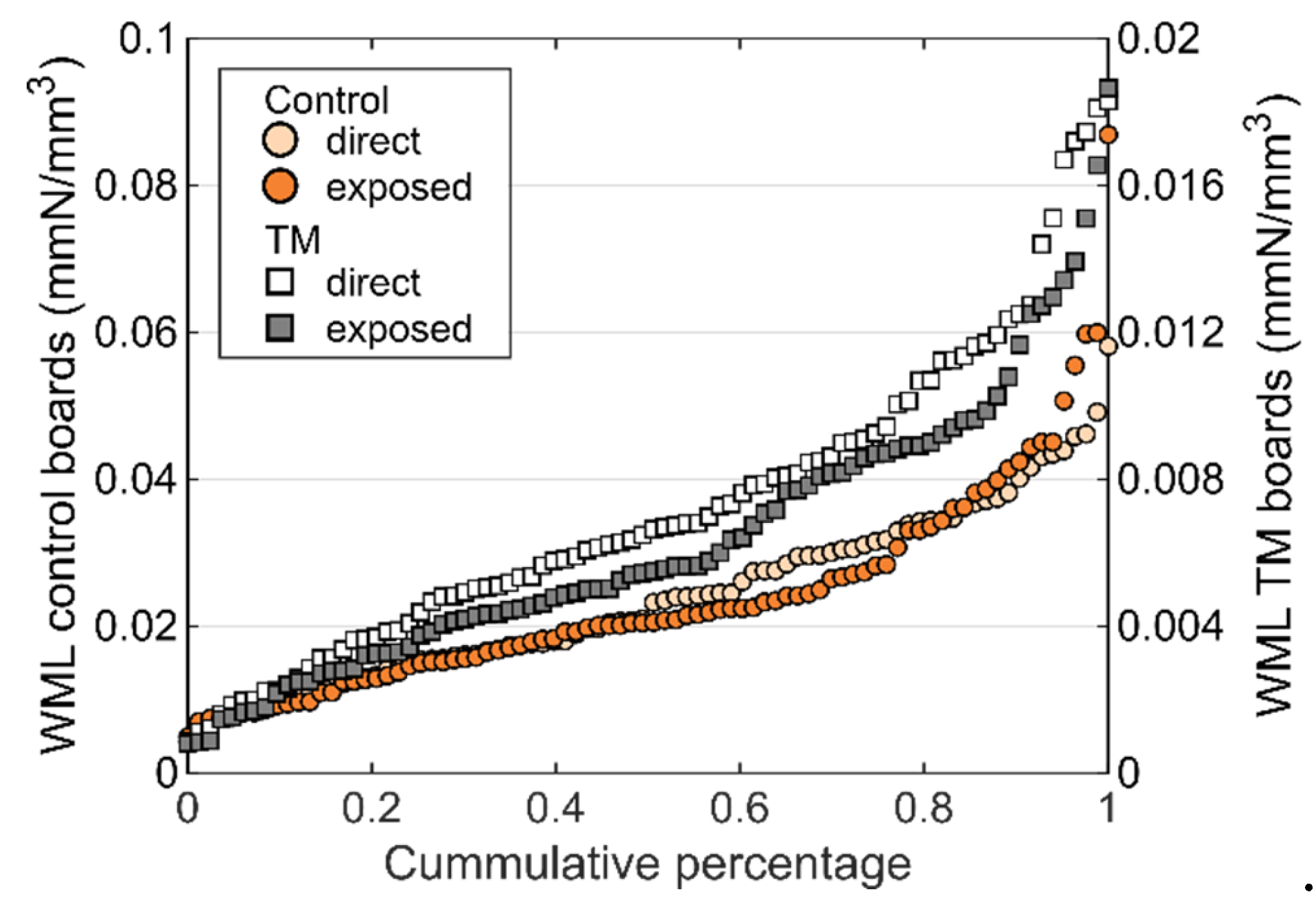
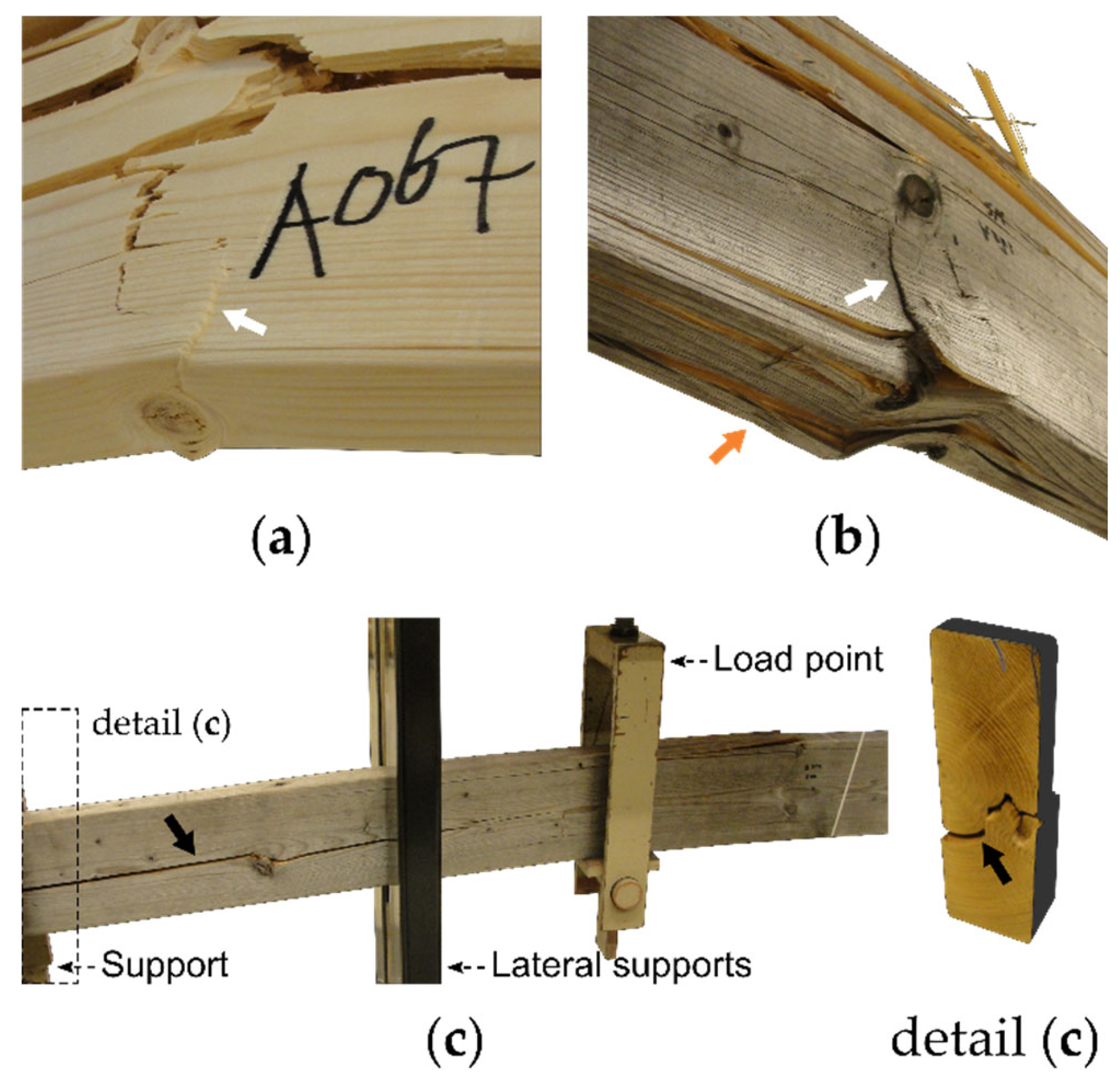
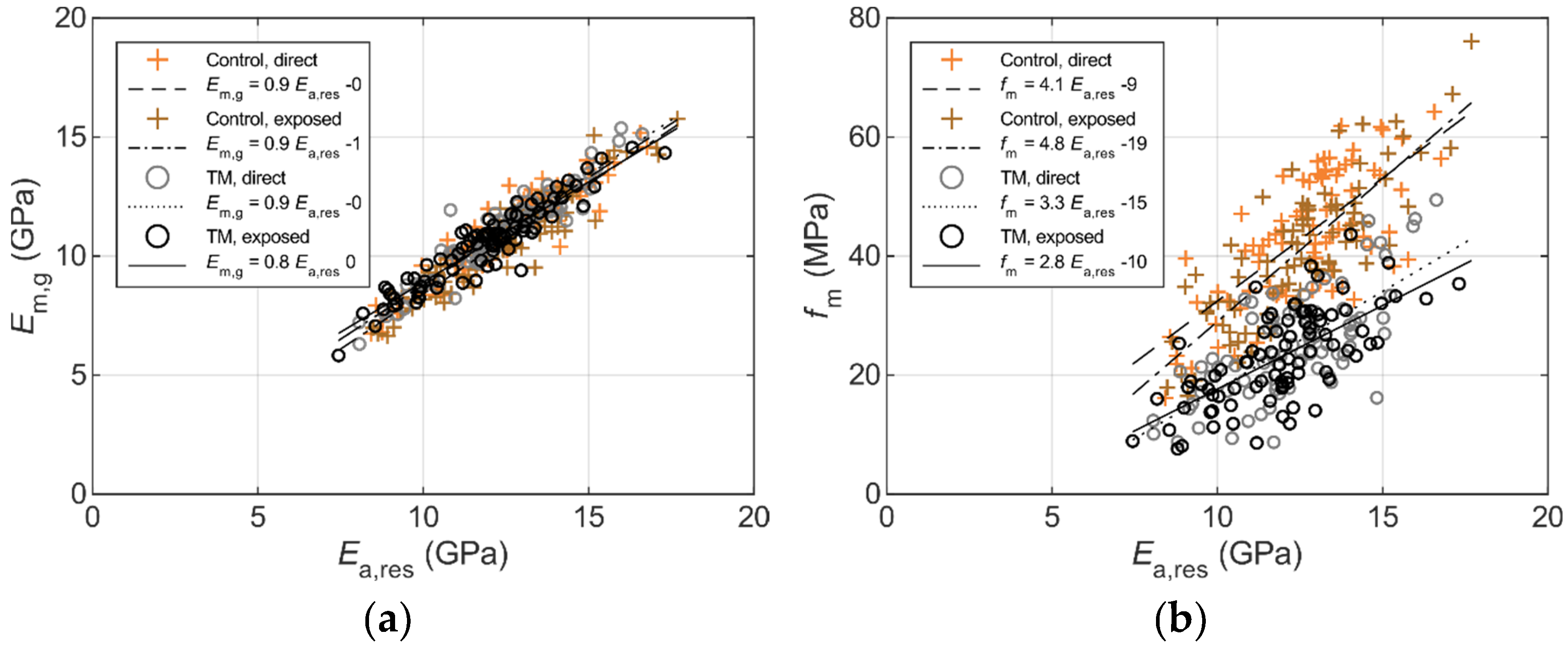
| Climate Factor Unit | Temperature 1 (°C) | Precipitation 2 (mm) | Solar radiation 1 (Wm2) | Relative Humidity 1 (%) |
|---|---|---|---|---|
| EXPOSURE PERIOD 3 | ||||
| Spring 2017–Autumn 2017 | 11.2 | 323 | 158 | 80 |
| Autumn 2017–Spring 2018 | 2.4 | 317 | 59 | 91 |
| Spring 2018–Autumn 2018 | 16.0 | 269 | 193 | 73 |
| Autumn 2018–Spring 2019 | 2.1 | 400 | 37 | 93 |
| Spring 2019–Autumn 2019 | 13.1 | 543 | 189 | 77 |
| MEASUREMENT INTERVAL 4 | ||||
| Autumn 2017 (month 6) | 8.5 | 5.5 | 57 | 94 |
| Spring 2018 (month 12) | 17.2 | 0.0 | 271 | 61 |
| Autumn 2018 (month 18) | 8.6 | 0.1 | 45 | 91 |
| Spring 2019 (month 24) | 6.9 | 0.0 | 174 | 64 |
| Autumn 2019 (month 30) | 7.0 | 0.3 | 134 | 86 |
| EN 14081-1 [62] | In this Work Referred to as | |
|---|---|---|
| Checks | Grade Determining Characteristics | |
| With a depth less than half the thickness | - | Surface checks |
| With a depth more than half the thickness | Length | Deep checks |
| Through the thickness | Length and position | Cracks, and if at board ends as splits |
| Treatment | Control | TM | ||||||
|---|---|---|---|---|---|---|---|---|
| Group(s) | All | Pith up | Bark up | Edge | all | Pith up | Bark up | Edge |
| ACROSS RINGS | ||||||||
| pith side | 3 c 4 (48%) | 4 4 a (75%) | 2 a 6 a (36%) | 1 a 2 a (32%) | 3 c 7 (68%) | 4 a 7 a (90%) | 2 a,b 7 a (63%) | 2 b 8 a (50%) |
| bark side | 3 7 c (88%) | 2 5(79%) | 5 a 9 (86%) | 4 a 7 (100%) | 3 7 c (98%) | 2 a 6 a (97%) | 4 7 a (100%) | 2 a 7 a (96%) |
| core | 1 c 17 c (1%) | 1 n/a 17 n/a (4%) | (0%) | (0%) | 4 c 27 c (18%) | 3 a 24 a (21%) | 2 a 35 a (11%) | 6 a 25 a (21%) |
| ALONG RINGS | ||||||||
| pith side | 3 3 (57%) | 3 a 3 a (54%) | 2 a 4 a (36%) | 4 a 3 a (82%) | 4 10 (93%) | 4 a 10 a (100%) | 3 a 10 a (81%) | 5 a 11 a (96%) |
| bark side | 2 c 3 c (5%) | (0%) | 2 n/a 3 n/a (4%) | 2 n/a 3 n/a (11%) | 2 c 7 c (39%) | 2 a 7 a (31%) | 2 a 9 a (37%) | 2 a 5 a (50%) |
| core | 1 c 9 c (1%) | (0%) | (0%) | 1 n/a 9 n/a (4%) | 3 c 25 c (1%) | (0%) | (0%) | 3 n/a 25 n/a (4%) |
| Treatment | Control | TM | ||||
|---|---|---|---|---|---|---|
| Exposure Interval | Direct | Exposed | Direct | Exposed | ||
| – | Before | After | – | Before | After | |
| NON-DESTRUCTIVE TESTS | ||||||
| ρ (kgm−3) | 463 39 8% | 457 39 9% | 457 39 9% | 422 33 8% | 417 a 35 8% | 422 a 36 9% |
| va,tof (ms−1) | 5560 b 231 4% | 5682 α,b 265% | 5665 α 270 5% | 5735 b 258 5% | 5852 a,b 279 5% | 5755 a 272 5% |
| Ea,tof (MPa) | 14,374 1997 14% | 14,786 α 2079 14% | 14,723 α 2117 14% | 13,929 1916 14% | 14,356 a 2047 14% | 14,029 a 1976 14% |
| va,res (ms−1) | 5208 254 5% | 5222 A 271 5% | 5211 A 296 6% | 5384 293 5% | 5384 a 319 6% | 5291 a 313 6% |
| Ea,res (MPa) | 12,623 1864 15% | 12,523 1975 16% | 12,488 2051 16% | 12,293 1876 15% | 12,173 a 1995 16% | 11,880 a 1908 16% |
| BENDING TESTS | ||||||
| MC (%) | 12.9c 0.7 c 5% | 13.5 a 0.4 3% | 12.3a,c 0.3 c 2% | 4.7 c 0.6 12% | 5.5 a 0.4 7% | 7.0 a,c 0.5 7% |
| fm (MPa) 1 | 43.3 10.8 25% (23.3) | N.A. | 40.9 11.7 29% (21.5) | 25.1 C 8.8 35% (10.8) | N.A. | 22.9 C 7.9 34% (10.2) |
| Em,g (MPa) | 11,151 1811 16% | N.A. | 10,708 2019 19% | 10,924 1825 17% | N.A. | 10,492 1709 16% |
| Em,l (MPa) | 12,381 1980 16% | N.A. | 12,408 2389 19% | 12,366 2198 18% | N.A. | 11,959 2077 17% |
| WML (mmN/mm3) | 0.0239 0.0116 49% | N.A. | 0.0238 0.0142 60% | 0.0073 0.0042 57% | N.A. | 0.0063 0.0038 59% |
| wmax (mm) | 44.4 10.7 24% | N.A. | 45.4 12.1 27% | 25.1 C 6.9 28% | N.A. | 23.1 C 6.5 28% |
| t (s) | 211 39 18% | N.A. | 212 43 20% | 145 c 28 19% | N.A. | 133 c 24 18% |
| Treatment | Control | TM | ||
|---|---|---|---|---|
| Exposure | Direct | Exposed | Direct | Exposed |
| Interval | – | After | – | After |
| CURVE TYPE 1 | ||||
| 1 | 15 | 21 | 37 | 56 |
| 2 | 47 | 40 | 63 | 43 |
| 3 | 15 | 17 | 0 | 0 |
| 4 | 23 | 23 | 0 | 1 |
| FAILURE TYPE | ||||
| Simple tension | 69 | 68 | 80 | 81 |
| Cross-grain tension | 27 | 16 | 18 | 13 |
| Splinter tension | 4 | 11 | 1 | 0 |
| Compression | 0 | 5 | 0 | 2 |
| Horizontal shear | 0 | 0 | 1 | 4 |
| DEFECT AT LOCATION OF FAILURE | ||||
| Around knots | 80 | 65 | 36 | 32 |
| Through knots | 13 | 30 | 56 | 61 |
| Reaction wood | 6 | 4 | 3.5 | 1 |
| Cross-grain | 1 | 0 | 3.5 | 0 |
| Top rupture | 0 | 1 | 0 | 2 |
| n/a 2 | 0 | 0 | 1 | 4 |
| FRACTURE SURFACE | ||||
| Brash | 38 | 24 | 64 | 50 |
| Fibrous | 62 | 71 | 35 | 44 |
| n/a 3 | 0 | 5 | 1 | 6 |
| Treatment | Control | TM | |||
|---|---|---|---|---|---|
| Bending Property | Em,g | fm | Em,g | fm | |
| ρ | direct exposed 2 exposed | 0.56 ± 0.14 0.53 ± 0.14 0.50 ± 0.15 | 0.16 ± 0.14 0.35 ± 0.16 0.32 ± 0.16 | 0.50 ± 0.15 0.40 ± 0.16 0.39 ± 0.16 | 0.17 ± 0.14 0.10 ± 0.12 0.12 ± 0.13 |
| Ea,tof | direct exposed 2 exposed | 0.80 ± 0.07 0.79 ± 0.08 0.77 ± 0.08 | 0.36 ± 0.16 0.61 ± 0.13 0.58 ± 0.13 | 0.82 ± 0.09 0.80 ± 0.07 0.79 ± 0.08 | 0.44 ± 0.15 0.38 ± 0.16 0.36 ± 0.16 |
| Ea,res | directexposed 2 exposed | 0.87 ± 0.05 0.88 ± 0.05 0.88 ± 0.05 | 0.51 ± 0.15 0.70 ± 0.10 0.69 ± 0.11 | 0.90 ± 0.04 0.88 ± 0.05 0.87 ± 0.05 | 0.49 ± 0.15 0.46 ± 0.15 0.45 ± 0.15 |
© 2020 by the authors. Licensee MDPI, Basel, Switzerland. This article is an open access article distributed under the terms and conditions of the Creative Commons Attribution (CC BY) license (http://creativecommons.org/licenses/by/4.0/).
Share and Cite
van Blokland, J.; Adamopoulos, S.; Ahmed, S.A. Performance of Thermally Modified Spruce Timber in Outdoor Above-Ground Conditions: Checking, Dynamic Stiffness and Static Bending Properties. Appl. Sci. 2020, 10, 3975. https://doi.org/10.3390/app10113975
van Blokland J, Adamopoulos S, Ahmed SA. Performance of Thermally Modified Spruce Timber in Outdoor Above-Ground Conditions: Checking, Dynamic Stiffness and Static Bending Properties. Applied Sciences. 2020; 10(11):3975. https://doi.org/10.3390/app10113975
Chicago/Turabian Stylevan Blokland, Joran, Stergios Adamopoulos, and Sheikh Ali Ahmed. 2020. "Performance of Thermally Modified Spruce Timber in Outdoor Above-Ground Conditions: Checking, Dynamic Stiffness and Static Bending Properties" Applied Sciences 10, no. 11: 3975. https://doi.org/10.3390/app10113975
APA Stylevan Blokland, J., Adamopoulos, S., & Ahmed, S. A. (2020). Performance of Thermally Modified Spruce Timber in Outdoor Above-Ground Conditions: Checking, Dynamic Stiffness and Static Bending Properties. Applied Sciences, 10(11), 3975. https://doi.org/10.3390/app10113975





